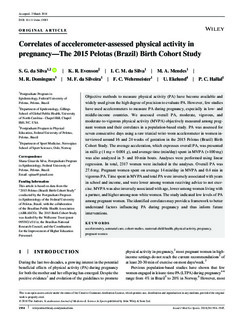| dc.contributor.author | Da Silva, Shana Ginar | |
| dc.contributor.author | Evenson, Kelly R. | |
| dc.contributor.author | Da Silva, Inacio C. M. | |
| dc.contributor.author | Mendes, Márcio A | |
| dc.contributor.author | Domingues, Marlos Rodrigues | |
| dc.contributor.author | Da Silveira, Mariângela Freitas | |
| dc.contributor.author | Wehrmeister, Fernando César | |
| dc.contributor.author | Ekelund, Ulf | |
| dc.contributor.author | Hallal, Pedro Curi | |
| dc.date.accessioned | 2019-01-07T11:22:53Z | |
| dc.date.available | 2019-01-07T11:22:53Z | |
| dc.date.created | 2018-10-08T14:35:24Z | |
| dc.date.issued | 2018 | |
| dc.identifier.citation | Scandinavian Journal of Medicine & Science in Sports. 2018, 28, 1934-1945. | nb_NO |
| dc.identifier.issn | 0905-7188 | |
| dc.identifier.uri | http://hdl.handle.net/11250/2579445 | |
| dc.description.abstract | Objective methods to measure physical activity (PA) have become available and widely used given the high degree of precision to evaluate PA. However, few studies have used accelerometers to measure PA during pregnancy, especially in low‐ and middle‐income countries. We assessed overall PA, moderate, vigorous, and moderate‐to‐vigorous physical activity (MVPA) objectively measured among pregnant women and their correlates in a population‐based study. PA was assessed for seven consecutive days using a raw triaxial wrist‐worn accelerometer in women interviewed around 16 and 24 weeks of gestation in the 2015 Pelotas (Brazil) Birth Cohort Study. The average acceleration, which expresses overall PA, was presented in milli‐g (1 mg = 0.001 g), and average time (min/day) spent in MVPA (>100 mg) was also analyzed in 5‐ and 10‐min bouts. Analyses were performed using linear regression. In total, 2317 women were included in the analyses. Overall PA was 27.6 mg. Pregnant women spent on average 14 min/day in MVPA and 0.4 min in vigorous PA. Time spent in MVPA and total PA were inversely associated with years in school and income, and were lower among women receiving advice to not exercise. MVPA was also inversely associated with age, lower among women living with a partner, and higher among non‐white women. The study indicated low levels of PA among pregnant women. The identified correlates may provide a framework to better understand factors influencing PA during pregnancy and thus inform future interventions. | nb_NO |
| dc.language.iso | eng | nb_NO |
| dc.subject | accelerometry | nb_NO |
| dc.subject | antenatal care | nb_NO |
| dc.subject | cohort studies | nb_NO |
| dc.subject | maternal-child health | nb_NO |
| dc.subject | physical activity | nb_NO |
| dc.subject | pregnancy | nb_NO |
| dc.subject | pregnant women | nb_NO |
| dc.title | Correlates of accelerometer-assessed physical activity in pregnancy?: The 2015 Pelotas (Brazil) Birth Cohort Study | nb_NO |
| dc.type | Journal article | nb_NO |
| dc.type | Peer reviewed | nb_NO |
| dc.description.version | publishedVersion | nb_NO |
| dc.rights.holder | © 2018 The Authors. Scandinavian Journal of Medicine & Science In Sports published by John Wiley & Sons Ltd. This is an open access article under the terms of the Creative Commons Attribution License, which permits use, distribution and reproduction in any medium, provided the original work is properly cited. | nb_NO |
| dc.source.journal | Scandinavian Journal of Medicine & Science in Sports | nb_NO |
| dc.identifier.doi | 10.1111/sms.13083 | |
| dc.identifier.cristin | 1618761 | |
| dc.description.localcode | Seksjon for idrettsmedisinske fag / Department of Sport Medicine | nb_NO |
| cristin.unitcode | 150,34,0,0 | |
| cristin.unitname | Seksjon for idrettsmedisinske fag | |
| cristin.ispublished | true | |
| cristin.fulltext | original | |
| cristin.qualitycode | 2 | |
